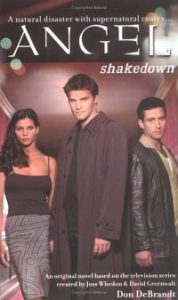In his only “Angel” novel, “Shakedown” (November 2000), Don DeBrandt delivers an enjoyable fly-by of an effort, mixing many of the things we enjoy about the franchise but not showing his hardboiled influences as much as one might like, considering he counts John D. MacDonald as a favorite author. The characterizations of the main trio are broadly correct – with Doyle working his demon contacts and Cordelia looking for a Hollywood “in” — although Angel is a bit quicker with a joke than we’re used to.
DeBrandt delivers borderline comedic philosophical fiction via the Tremblors, a race of rock demons responsible for many of the major earthquakes throughout history. Angel puts a pickax into the skull of one named Baasalt, causing the demon’s mind to expand. Previously, the rock demons mostly just existed, ceremonially sacrificing four humans (a.k.a. “Skin-Dwellers”) every century or so to create a new rock demon but mostly being terrified of the surface. The pickax causes Baasalt to learn about basic principles of human violence, such as throwing a stone at a human to injure him, and he starts to imagine taking over the surface and ruling humans.
The author also invents the Serpentene race of demons, who are descended from snakes (tying into the Adam and Eve myth) even though they look human now. He plays with the idea of Cordelia befriending a fashion-conscious Serpentene woman, which gets Doyle’s hopes up that Cordy will change her mind about demons. The Serpentene recruit Angel in the fight against the encroaching Tremblors. But DeBrandt doesn’t seem to be into this thread as much. An epilogue explains how Wolfram & Hart (making their novel debut) tie into this conflict between two demon races, but there aren’t many clues in the narrative to allow us to figure it out.
DeBrandt can’t resist playing with a couple notions from the relatively slow-burn TV series. In exchange for information, Angel agrees to take Kate out for a dinner and wine. But, in an extended riff on what happens when Cordelia and Wesley kiss in “Buffy” Season 3, they have nothing to talk about on the pseudo-date, as Angel’s views on topics are either nonexistent (sports) or a century behind the times (music). How this fits with the TV narrative is shaky, because we know Kate’s attraction to Angel is not erased by this bad date.
The most intriguing passage comes when Angel is under the influence of the Tremblors’ mind control. He imagines he’s in a mall and walks into a store called Angelus Fashions. There he faces off with Angelus, an idea that the TV series wouldn’t get to until “Orpheus” (4.15). Angelus shows him some of his masterpieces of horror (which Angel feels responsible for, too), including his torture of a woman during the Portugal earthquake of 1755, something that DeBrandt has been peppering throughout the narrative.
With nasty Angelus-Darla flashbacks, a decent case, humor and the invention of two demon species, “Shakedown” bounces between tones but is a page-turner for that very reason. Ultimately, the whole is less than the sum of its parts, as the author is focused on some ideas — like the Tremblors — but skims over others in a throwaway fashion, like when Doyle blows all his money at the races. And it’s not ideal that “Shakedown” comes on the heels of “Close to the Ground,” which also features action in the tunnels beneath Los Angeles. Still, DeBrandt has a good handle on how to write a novel in the “Angel”-verse, and I would’ve enjoyed more from him.

Click here for an index of all of John’s “Buffy” and “Angel” reviews.

